
April 2010

30 April 10
‘ Dr. Rosenbach and Mr. Lilly ’

— Joel Silver. Dr. Rosenbach and Mr. Lilly. Book Collecting in a Golden Age . Newtown, Pa.: Bird & Bull Press, 2010. Title page printed in red and black, with vignette (repeated at chapter headings), with plates in color facsimile. 131 pp. Edition of 140 copies printed on Arches mouldmade paper.
The tale is quickly told : Dr. A. S. W. Rosenbach was the greatest rare book dealer in the first half of the twentieth century, through whose hands passed some of the greatest books and manuscripts in the world. J. K. Lilly, Jr., was a wealthy American collector who bought some of the most important books in his library from Rosenbach, and who in 1960 donated his collection of literature and Americana to Indiana University, and the Lilly Library, one of the major American rare book libraries, celebrates its fiftieth annversary this year. But the real interest in this story, in any story, is in how the tale is told.
Joel Silver, a master of succinct, well documented studies of books and their owners, has has written a graceful and compelling biographical narrative. Dr. Rosenbach and Mr. Lilly recounts the dance of mutual suspicion and respect that characterized relations between Rosenbach and Lilly. It is never simply a question of buying books — although Silver includes a list of books that Lilly purchased from Rosenbach by Lilly — but of timing, opportunity, and patience, as the collector became more discerning about what he really intended his library to be, and the availability of books as shaped by circumstances in the world and in the fortunes of Dr. Rosenbach. Silver draws upon published sources as well as upn correspondence, documents, and books in the Lilly Library and in the archives of the Rosenbach Museum and Library in Philadelphia. Key documents, title pages, and bindings are reproduced in superb color facsimile, and the book is superbly produced. It is a joy to hold in the hands and read.
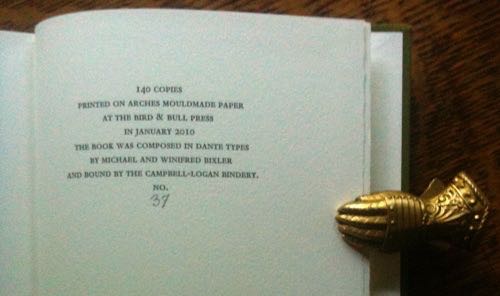
Dr. Rosenbach and Mr. Lilly covers a small chapter in the lives of Lilly and Rosenbach : Lilly bought most of his books from Scribners and David Randall, who became the first librarian of the Lilly Library. Rosenbach had customers all over the country and knew how to keep the spotlight of attention upon his public activities. Silver uses these events of narrow compass to articulate insights about the nature of collecting and about the literature of book collecting ; and like other great writers, he knows when to turn his gaze to the distant horizon. How the Lilly Library obtained a copy of the first edition of Bunyan’s Pilgrim’s Progress , an extraordinarily rare book known in a handful of copies, is a narrative thread that became part of the story only after the death of both Rosenbach and Lilly. The concluding paragraph of Silver’s Epilogue is a brilliant piece of writing.
The world of rare books is a small one. Candor obliges your correpondent to disclose that he bought his own copy of Dr. Rosenbach and Mr. Lilly because of long ties of friendship with the author, whom he has known in print since his first day on the job at AB Bookman’s Weekly in the fall of 1996, and personally soon thereafter. Magazines come and go, friendship endures. But about the charms of Dr. Rosenbach and Mr. Lilly there is no doubt : at midnight the other evening, I picked up Silver’s book after completing the trial binding of the next book from Temporary Culture, intending to read just a few pages. An hour later, I finished reading the book ; and re-reading it has confirmed my estimation of the book’s strengths.
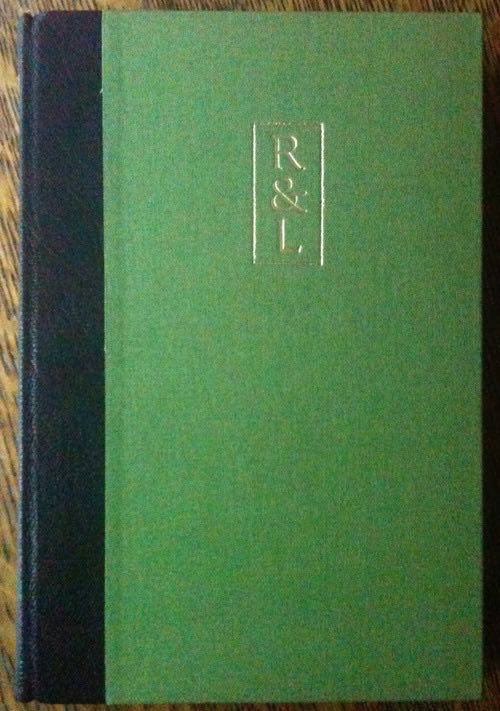
— — — —
Taxonomies
One of the recurring interests of the Endless Bookshelf is the Taxonomy of the Book Trade, that is, the identification and description of the plumage, habitat, and behavior of individuals in the book trade. It is a rare thing to encounter case studies of what one might call (with equal apologies to Ed Maggs and to Linnaeus and Audubon) the Giant Raptor class. The number of these is necessarily small and in some instances the population may be unique, unsustainable, non-breeding, and extinct. It was very interesting to learn in detail about how a collector at the top of his own ecological niche dealt with the techniques and displays of the great Dr. Rosenbach.
Temporary Culture
Monday 3 May is publication day for The
Man with the Knives by Ellen
Kushner, who will be appearing (along with your correspondent)
on the Hour of
the Wolf radio program, tomorrow morning, Saturday 1 May from
5:00 to 7:00 a.m., on WBAI-FM in New York City.
The Endless Bookshelf will next update on Tuesday 4 May. Please continue
to send lists of the Last Three books read.
26 April 10
‘ The Recurrent Problem of Civilization ’
— Margaret Mead. Male and Female. A Study in the Sexes in a Changing World William Morrow, [1949].
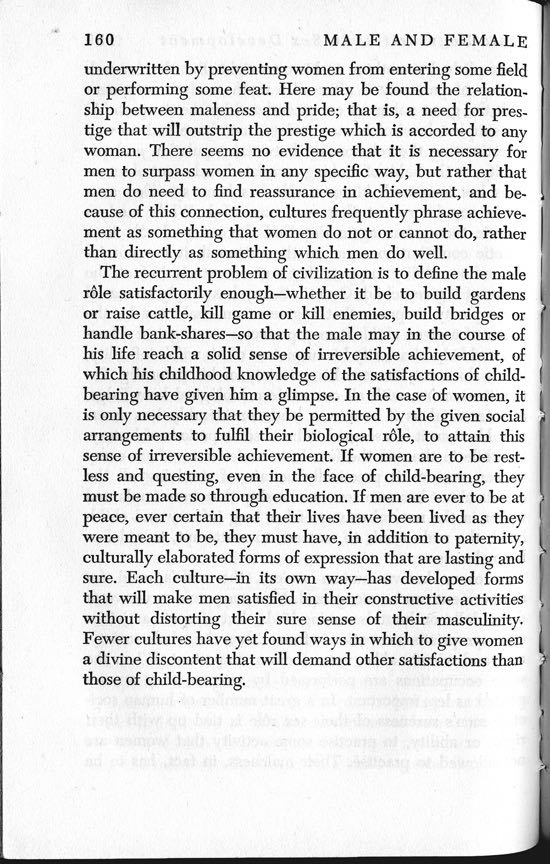
A query on John Crowley Little and Big tracing the source of a truism about the “ recurrent problem ” of civilization prompted me to visit the library. The original in context (above) is far more complex and intertwined than simply “ finding something for the men to do ”. To take any single sentence of the paragraph without the whole and, especially, to omit the last sentence, distorts Mead’s argument.
The recurrent problem of civilisation is to define the male rôle satisfactorily enough — whether it be to build gardens or raise cattle, kill game or kill enemies, build bridges or handle bank-shares — so that the male may in the course of his life reach a solid sense of irreversible achievement, of which his childhood knowledge of the satisfactions of childbearing have given him a glimpse. In the case of women, it is only necessary that they be permitted by the given social arrangements to fulfil their biological rôle, to attain this sense of irreversible achievement. If women are to be restless and questing, even in the face of child-bearing, they must be made so through education. If men are ever to be at peace, ever certain that their lives have been lived as they were meant to be, they must have, in addition to paternity, culturally elaborated forms of expression that are lasting and sure. Each culture — in its own way — has developed forms that will make men satisfied in their constructive activities without distorting their sure sense of their masculinity. Fewer cultures have yet found ways in which to give women a divine discontent that will demand other satisfactions than those of child-bearing.
And then other things started appearing and unpacking their baggage.
— — — —
‘ Stories for Men ’
This morning I came across MOST ESSENTIAL 50 BOOKS FOR MEN, a list of cultural, sartorial, and gastronomical books compiled by Thomas Fink, author of The Man’s Book (Little, Brown, 2009). A few of his comments :
The Ashley Book of Knots [1944] — Universally regarded as the most comprehensive and entertaining book on knots, with details on over 3,900.
With or Without Beans [1952] — The subtitle is ‘ Being a compendium to perpetuate the internationally-famous bowl of chili (Texas style) which occupies such an important place in modern civilization ’.
Esquire’s Encyclopedia of 20th Century Men’s Fashions [1973] is the full name of the best overview of the trends in men's dress. Copies are now considered prize possessions, and second-hand copies are expensive.
Arnold : The Education of a Bodybuilder [1977] — The best book on weights, even more for its tale of extraordinary mental discipline than its back-to-basics exercise prescriptions. The first half is autobiographical and the second details exercises and lifting routines.
Such lists always prompt me to attempt to elucidate the criteria that define the selection. There are some witty choices, such as Baker’s Gentleman’s Companion (1939), and a decided emphasis on style and its visual components. These are without doubt “ culturally elaborated forms of expression ” but do they form a pathway to the solid sense of irreversible achievements Mead describes ?
Perhaps unsurprisingly, there are few books by women. Literature, too, has only a small place on the list : Walton’s Compleat Angler (1653), Lermontov’s A Hero of Our Time , Waugh’s Brideshead Revisited (1945), and The James Bond Bedside Companion by Raymond Benson, 1984. I would not have been surprised to see the following, but it does not figure on Fink’s list.
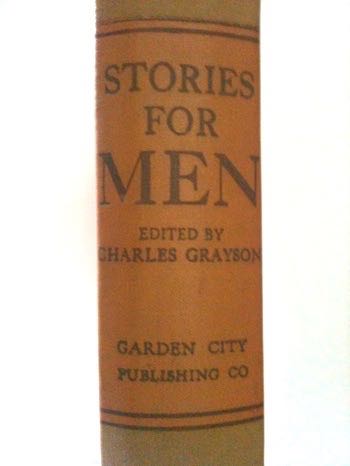
— Charles Grayson. Stories for Men. An Anthology . Deluxe Edition (1936 ; Garden City Publishing Co., [1944]). “ Simply, it is just a bundle of yarns by present day American writers, each dealing with a different phase of the actions and activities of men . . . ”
This prompted recollections of John Kessel’s complex tale “ Stories for Men ”, a critique of the Grayson anthology, of the notion of machismo, and, given the lunar colony setting, of Heinlein’s The Moon Is a Harsh Mistress . Kessel’s “ Stories for Men ” is part of the Lunar Quartet and is collected in The Baum Plan for Financial Independence and Other Stories (Small Beer Press, [2008]).
— — — —

And so I am reminded of a small pamphlet I found among my father’s papers, To a Boy Who Is about to Become a Young Man , by W. Lee Gwynne, assisted by Lee Gwynne Martin (Second edition, privately printed, Hamilton, Bermuda, 1941). This is essentially a mid-century guide on how to be a WASP, and chiefly utilitarian and conformist in its philosophy. It is a rare book and an unusual imprint. OCLC records only a single copy of the 1938 first edition at the New York Public Library.
It is also an extinct dinosaur from a world struck by a comet : a paper fossil from the time before Male and Female , the feminist movement, and decades of rapid social change.
A Private Library

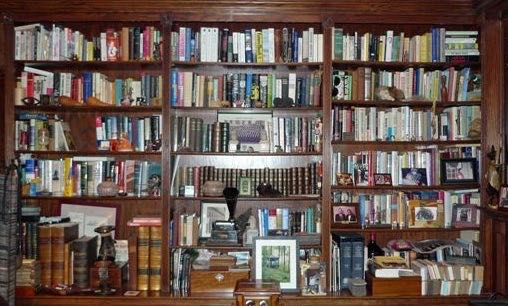
Sent by new reader [JER]. Thank you !
The Last Three
[MD]:
— Isaac Asimov, The Foundation Trilogy (1951, 1952, 1953 ; Bantam paperbacks, 2008). Re-read, for an introduction to a new edition
— Anne Carson, Nox . New Directions, 2010. An elegy for her brother. Read, for a review
— Marilynne Robinson, Housekeeping . Farrar Straus &
Giroux, 1980. One of the dozen best American novels of the last 30 years. Re-read,
for
a talk
[RD]:
— William Shakespeare, The Tempest , ed. by Jonathan Bate and Eric Rasmussen. The RSC Shakespeare, The Modern Library, 2008
— R. Crumb. The Book of Genesis Illustrated . W. W.
Norton & Company,
2009
— Kim Stanley Robinson, Galileo's Dream . Ballantine Books, 2009
— Stephen Greenblatt, Will in the World: How Shakespeare Became
Shakespeare . Norton, 2004
[AG]:
— Christopher De Hamel, The Book : A History of the Bible . 2001.
Re-read
— David Sedaris, When You Are Engulfed in Flames . 2008
— Phyllis Walter Goodhart Gordan, ed., Two Renaissance Book Hunters
: The Letters of Poggius Bracciolini to Nicolaus de Niccolis . 1974
[JW] :
— Elif Batuman, The Possessed : Adventures with Russian Books & the
People Who Read Them . Farrar, Straus & Giroux, 2010
— Philip Core, Camp : The Lie That Tells the Truth . 1981.
Re-read.
— O.E. Shoeffler and WIlliam Gale, Esquire’s Encyclopedia of 20th
Century Men’s Fashions . McGraw-Hill, 1973. Re-read.
[SF] :
— Catherine Drinker Bowen, Miracle at Philadelphia: The Story
of the Constitutional Convention, May to September, 1787 . (New York, 1986.). Re-read
— Richard B. Morris, The Forging of the Union, 1781-1789 . (New York, 1987)
— Dard. Hunter, Papermaking ; The History and Technique of an
Ancient Craft . (New York, 1943)
[FL] :
— Audrey Niffenegger, The Time Traveler’s Wife . (2003 ; Harcourt,
2004)
— Josep M Carandell, The Palau de la Musica Catalana . Barcelona :
Triangle Postals, 2006
— Charles Stross, The Revolution Business . (2009 ; Tor
paperback, 2010)
[GG] :
— Holly Black, The Red Glove . Simon & Schuster, forthcoming, 2011
— Lydia Millet, The Fires Beneath the Sea . Big Mouth House, forthcoming, 2011. Re-read
— Mark Rich, Edge of Our Lives . Redjack, 2008
[DW] :
— Roald Dahl, Charlie and the Chocolate Factory . (most recently read book ; aloud with my son ; a re-read)
— Neil Wechsler, Grenadine . Yale University Press,
2009. (read several times)
— Jed Perl, Antoine’s Alphabet: Watteau and His World . Knopf, 2008
Current Reading :
— Suzanne L. Marchand. German Orientalism in the Age of Empire. Religion, Race, and Scholarship . German Historical Institute and Cambridge University Press, [2009].
— David Peace. Occupied City. Alfred A. Knopf, 2010. Formally innovative detetcive novel set in 1948 Tokyo.
— Ashley Montague. The Anatomy of Swearing . The Macmillan Company, [1967]. This is why one goes to a library with open stacks, or to a bookstore, to find the book a couple shelves over from the title sought.
Recent Reading :
— Alisa Kwitney. Sex as a Second Language (2006 ; Washington Square Press paperback, 2008).
— Rex Stout. Fer-de-Lance [and :] The League of Frightened Men (1934, 1935 ; Bantam paperback, 2008).
Justification for Existence : on or off the Shelf
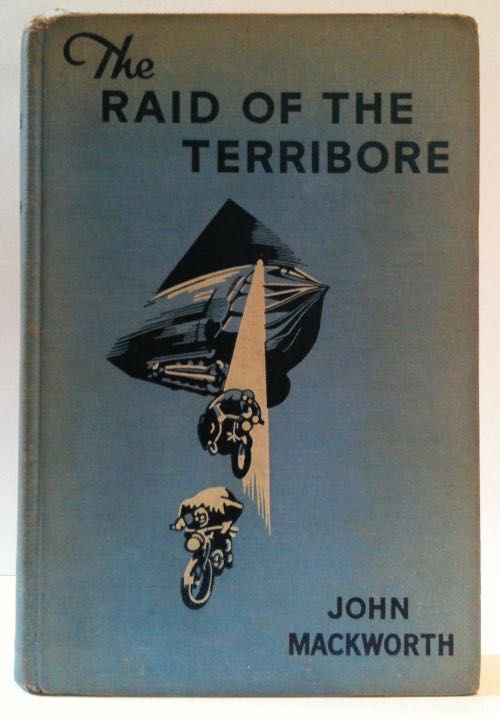
— John Mackworth. The Raid of the Terribore. A Modern Adventure Story . Color frontispiece by Reginald Mills, illustrations by Thomas Somerville. Lippincott, 1937. Originally published in London as The Menace of the Terribore . Two boys and their motorcycles against the evil count Fhurgo who seeks to rob the Bank of England. This is a book to take off the shelf to look at the image on the front cover .
Others, such as the following, need only their title to earn a place on the shelf :

— Rhys Hughes. The Smell of Telescopes . Tartarus Press, 2000. First edition, no. 186 of 250 copies signed by the author. Black cloth, printed dust jacket. I first learned of the work of Rhys Hughes when I received my contributor’s copy of the Scribners Supernatural Fiction Writers, Second Edition, edited by Richard Bleiler. The entry on Hughes by E.F. Bleiler seemed a fantastical creation ; I was surprised to learn that the author and his books were real.
18 April 10
Magical Realism : Where It Started


— HUDSON, W.H. The Purple Land That England Lost, Travels and Adventures in the Banda Oriental, South America . With 32 pp. advertisements at end of vol. II, dated October 1885. 2 vols. 8vo, London: Sampson, Low, Marston, 1885. First Edition, binding variant A. Original light blue cloth decorated in red, spines titled in gilt. Bookseller ticket of Robert M’Clure, Glasgow. Some minor rubbing. A.E. Newton copy in custom dark blue morocco backed slipcase with his device, cloth chemise. Payne A1a; Wilson 1; Carter, “ More Binding Variants ” (1938), pp. 10-11; A.E. Newton sale (15 May 1941), lot 329 (this copy).
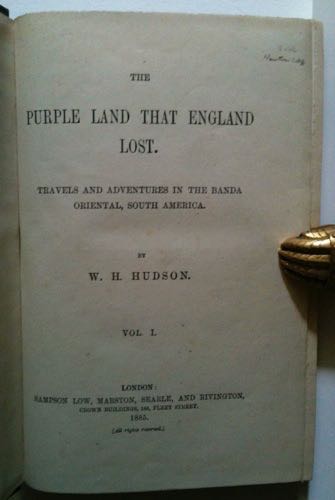
Hudson is out of fashion again nowadays but his first book is well worth reading. Praised by Borges as “ one of the very few happy books in the world ”*, The Purple Land is a loosely structured memoir chronicling the wanderings of Richard Lamb in the Banda Orientál (now Uruguay). The book is populated with a cast of startling originality : very macho Gaucho revolutionaries, ardent and headstrong women, crazed patriarchs, beautiful children, renegade Britons (noble and ignoble). If this seems to be the stuff of latter-day Latin American novels, Hudson did it first, and wrote with a flair for describing landscapes and nature. The Purple Land is clearly the first work of magical realism (or Magic Realism), all the more remarkable for its Latin American setting, for Hudson’s graceful prose, and for being published forty years before the Germans began to use the term.

Chapter XX, “ Tales of the Purple Land ”, includes tales told around the fire by Lamb and the other defeated irregulars of the Blancos, “ wild creatures of strange appearance and habits, apparitions, and marvellous adventures ” : how the lampalagua hunts, unusual events in a hut in a swamp, and battling with a demon. Lamb’s attempts to tell a story of fog and snow in London are greeted with a profound skepticism : “ Surely, friend, you do not consider us such simple persons in the Banda Oriental as not to know truth from fable ? ” The Peralta Estancia and its inhabitants are as baroque and tragic a creation as anything in A Hundred Years of Solitude . The Purple Land is a splendid book evoking a distant era ; little wonder that Borges the Anglophile had a great liking for this work and remarked on the accuracy of Hudson’s portrayal of the Gaucho.
The Purple Land is one of the favorite books of the Endless Bookshelf, and this post is loosely adapted from a Read This ! column published in NYRSF ca. 2000 ; I bought the A.E. Newton copy of the first edition some years later. Larger format pictures here. In reprint editions, the “ Tales of the Purple Land ” appear as chapter XIX. [HWW]
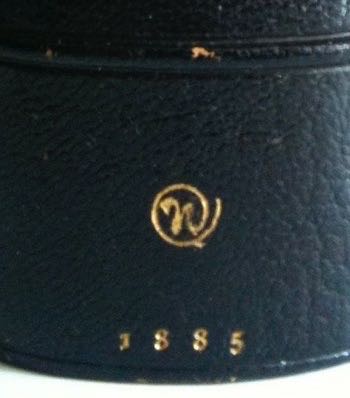
The Last Three
[DM] :
— Taylor Branch, The Clinton Tapes : Wrestling History
with the President . Simon & Schuster, 2009
— Hugo Claus, Wonder , translated by Michael Heim. Archipelago
Books, 2009
— Michael Palmer, Promises of Glass . New Directions,
2000
— Karl O. Knausgaard, A Time for Everything , trans. by James
Anderson. Archipelago Books, 2008
[MLV] :
— Edmund Crispin, The Glimpses of the Moon . Gollancz,
1977. The final adventure of Gervase Fen, Oxford don and detective
— George Charles Williamson, Lodowick Muggleton, A Paper Read
before ye Sette of Odd Volumes, At ye 337th Meeting, January 27, 1915
by Bro.
George Charles
Williamson, Horologer to ye Sette . Imprynted for ye Author
at ye Chiswick Press and to be had of no bokesellers, 1919. An account
of a seventeenth-century
millenarian prophet, his followers, and his books
— Robert Byron, Letters Home . John Murray, 1991.
Correspondence of the Thirties travel writer, author of The Road
to Oxiana
[EFH] sends four, “ The last two are reference works for my
novel-in-progress. ”
— Kem Nunn, Tapping the Source . Delacorte Press, 1984.
The definitive surf-punk noir, re-read for the sixth or seventh time
— Monica Furlong, Wise Child. Gollancz, 1987. Novel set
in sixth-century Scotland
— Source Book of Seid , edited and translated by James
Chisolm and Stephen E. Flowers. Runa-Raven Press, 2007. Source material relating
to seid (Icelandic sorcery) in the Icelandic sagas
— The Galdrabok , translated by Stephen E. Flowers.
Revised second edition, Runa-Raven Press, 2010. Translation of a Medieval Icelandic
grimoire
[MJS] :
— Hendrik de Leeuw, Sinful Cities of the Western World .
Citadel Press, 1947, tenth printing.Nonfiction. Visits to exotic brothels
in the 1930s.
— Margaret Drabble, The Pattern in the Carpet : A Personal
History With Jigsaws .
Houghton Mifflin Harcourt, 2009, first American edition
— Alexander Dumas’ Adventures in Caucasia , trans. & ed.
by A. E. Murch. Chilton Books, 1962, first American edition. Nonfiction,
in which Dumas père fights Chechen bandits !
[DVS] :
— Michael Bloch, James Lees-Milne : The Life .
John Murray, 2009, Second printing. Who knew the Brits were as oversexed
as Tiger Woods? Surely not I
— Vladimir Nabokoff, Laughter in the Dark , Bobbs-Merrill,
1938. A jacket-less copy in worn pea-green boards. “ Once upon a time . . . ”
— Sue Bradley, ed., The British Book Trade : An Oral History .
British Library, 2008. Tales of bookselling over the last 60 years, expertly
arranged. A way of life — martinis with lunch; editing and
selling as not only a trade but a profession — rapidly being lost
With the Last Three project, the Endless Bookshelf has provoked a suitable level of interactivity — solicited or cajoled, but interactivity all the same — and what a diverse range of titles ! And how consistently three is read as four ! Your correspondent will continue to post such reports as they are received. This IS an invitation.
15 April 10
Display of manuscripts and shelving cases, from the library of Sir Thomas Phillipps, in the Grolier Club, New York City.
The Last Three
“ Mostly read while en route between my home in Chigasaki and work in Tokyo,
Japan. ” [DC] :
— Alan Tansman, The Aesthetics of Japanese Fascism
— Elizabeth Jane Howard, The Light Years
— M. Thomas Gammarino, Big in Japan. A Ghost Story
[EK] :
— Gerald Bullett, Mr. Godly Beside Himself . John Lane The Bodley Head Ltd.,
[1924]
— Hope Mirrlees, The Counterplot . Alfred A. Knopf, [1925]
— John Bellairs, The House with a Clock in Its Walls , in The
Best of John Bellairs . Dial Books, [2005], with the Gorey
illustrations (re-read)
Bonus with colorful pictures :
— Mike Mignola and Ben Stenbeck, Witchfinder. In the
Service of Angels . Dark
Horse Books, [2010]
A “ classics fest ” from [SS] :
— Anthony Trollope, The Way We Live Now
— Evelyn Waugh, Vile Bodies
— Robert Graves, I Claudius
[DR] :
— Jonathan Lethem, Chronic City
— Jaron Lanier, You Are Not A Gadget
— Alfred Korbzybski, Science and Sanity. An Introduction to
Non-Aristotelian Systems and General Semantics. Fifth edition, Institute
of General Semantics, 1933/2005
[IRR] :
— Evelyn Waugh, A Handful of Dust. Penguin, [2000].
Suddenly realised that I had never actually read it . . .
— Sue Grafton, U is for Undertow . Macmillan, [2010]. Because
I've read all of them (& this one was a particularly good one)
— Rael Isacowitz, Pilates. Human Kinetics, [2006]. Constant companion at the
moment to remind me of the exercises
[JW] :
— Stieg Larsson, The Girl with the Dragon Tattoo . Kindle edition
— Michael Murphy, Golf in the Kingdom . 1972
— Daniel Defoe, The Life and Most Surprising Adventures of Robinson Crusoe .
1801 printing
[DW] :
— Freud & Jung, Barnes and Noble reprint, originally published by Oxford
University Press in their Past Masters Series
— The Way of Lao Tzu (Tao-te ching) , Translated with introductory essays, comments
and notes by Wing-Tsit Chan, Macmillan, Library of the Liberal Arts, 1963
— Richard Bachman, The Regulators, Signet 10th printing
Defining terms
The Last Three continues to evolve : one correspondent asked, “ do
we have to have finished the books ? ” while another diagnosed “ a
mild bout of despair at the number of started but unfinished books (mostly
academic) surrounding my desk. Thank goodness for the spiritually elevating
properties of cake. ” It was also heartening to see that others recognized
the arbitrary nature of the Last Three and added a fourth title.
The sub-categories of Books Abandoned or Books Consulted for Reference
are interesting but for purposes of the Last Three it is Books
Read that
should be recorded : the books that compel and retain
a reader’s attention. Along the same lines, when The Nutmeg Point
District Mail and
the Avram Davidson Society announced the Golden
Nutmeg Award in 1997, the editor of the District
Mail, for want of time, declined to entertain nominations
for a Wooden Nutmeg Award.
Current Reading :
— Louise FitzHugh. Harriet the Spy. Written and illustrated by . . . . (1964 ; Dell paperback, [2001]). When three friends traded praises of this book, and reader [PW] joined in, I pulled this off a shelf, and wonder how I missed it at an earlier stage. Do they still sell green composition books or are they all made with black covers ? I will return to yesterday’s German orientalists in a little while ; for now, sneaky Harriet has elbowed them aside.
14 April 10
The Last Three
Readers are invited by the Endless Bookshelf to send lists of the last three books read : author, title, and date of the edition (if possible), please. Please indicate if a re-read.
Roving correspondent [GM] reports the following, from a train somewhere
between Paris and London :
— Clarice Lispector, The Apple in the Dark
— Maurice Rowdon, The Ape of Sorrows
— Jacques Cauvin, The Birth of the Gods and the Origins of
Agriculture ( “ a re-read, I’ll understand it eventually ” )
Your correspondent [HWW] submits the following :
— Mark Valentine and John Howard, The Collected Connoisseur . Tartarus,
[2010]. Collection of short stories on fantastical/aesthetic topics, for
a review.
— Abraham Lansing, The Log Book of Camp Albany [1883-1898], in Recollections .
Privately printed, 1909.
— Wilkie Collins. The Moonstone. A Novel . With illustrations.
Harper & Brothers,
Publisher, [c. 1875, but 1882].
Plus :
— Dan Wechsler’s new picture book, Strange and Wonderful.
An Informal Visual History of Manuscript Books and Albums . Sanctuary Books, [2010].
Wendy Walker [WW] reports reading in Antigua, Guatemala :
— Anthony Trollope, Mr. Scarborough’s Family (the
first book by him I really enjoyed, and apparently his last, posthumously
published)
— Penelope Chetwode, Two Middle-Aged Ladies in Andalusia (one
of the ladies is herself, the other is her horse)
— P.G. Wodehouse, The Girl in Blue (good, late Wodehouse)
From [EH] :
— Paul Muldoon, New and Selected Poems
— Cormac McCarthy, The Crossing
— Anton Joachimsthaler (Helmut Bogler, trans.), The Last Days of Hitler : Legend,
Evidence and Truth
The Collected Connoisseur
— Mark Valentine and John Howard. The Collected Connoisseur . Tartarus Press paperback, [2010]. viii, 306 pp. Collection of 23 stories, comprising Valentine’s earlier books In Violet Veils (1999), Masques and Citadels (2003), a selection from an elusive collaboration by Valentine and Howard, The Rite of Trebizond (2008), and one uncollected tale.
I encountered Masques and Citadels last year, and wrote about it here, including the following :
The “ detective ” is an aesthetic man of action (as if Sherlock Holmes had been addicted to poetry and synaesthesia instead of . . . ).
I am at work on an extended review of The Collected Connoisseur.
— — — —
Current Reading :
— Suzanne L. Marchand. German Orientalism in the Age of Empire. Religion, Race, and Scholarship . German Historical Institute and Cambridge University Press, [2009]. I can’t wait to dive into this : biographies of scholars, reflections on the implications of scholarship, accounts of little known expeditions, and “ the intellectual consequences of the central Asian antiquities race ”.
— — — —
Bookshelves at Home
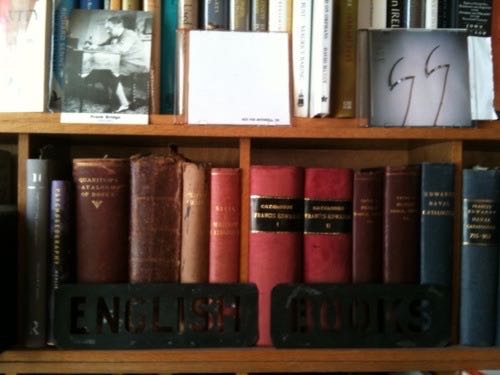
— in my “ study ” at home [GM]
Hypertext before the internet : Extra-illustrated Books
The simplest definition of an extra-illustrated book is a standard printed text rebound with added, interleaved visual annotations (portraits, views, etc.) and other manuscript or printed inserts. The addiitons can range from a few enrgaved portraits of characters added to a Dickens novel to supplement the original plates, or a scattering of portraits of an author at various stages of life in a one volume biography, to systematic expansions of a book into imposing and monumental multi-volume sequences. Illustration (which we now call extra-illustration) reached its heyday in the late nineteenth century, and there is a well-documented history of the practice. Glaister’s Glossary of the Book employs the term “ Grangerized ” but this refers specifically to books “ in which blank leaves are left for the addition by the purchaser of illustrations to his taste. The term derives from James Granger, (1723-76), copies of whose ‘ Biographical History of England ’, 5 vols., 1769-74, were bound up with blank leaves in this way ”. There are aspects of the extra-illustrated book of the nineteenth century that anticipate the infinitely networked aspects of text and knowledge cited by proponents of the electronic book.
I was struck by this notion while collating — leafing through — a recent example that crossed my desk, a well-known literary biography illustrated through the addition of a large collection of portraits, caricatures, landscape views, and architectural renderings in a variety of media (engravings, proof prints, mezzotints, aquatints, and watercolor drawings), press clippings, manuscripts and proof printings of essays, pamphlets, manuscript copies of letters, ephemera, and autograph letters of minor figures, more than 1,000 insertions. Notable about this extra-illustrated copy was that the material had been compiled before 1869 by a single individual who also wrote and thought about aspects of the material and about the cultural significance of the subject of the biography in the broadest sense. The visual annotations included some early uses of the subject’s name and portrait in advertising. A recent exhibition at the Grolier Club, A Monument More Durable than Brass, was chiefly concerned with primary materials (autographs, books, letters, and relics of Dr. Johnson and his circle) but did include a case on the spread of Johnson’s persona and portrait into advertising for beer and stationery. In a similar fashion, the extra-illustrated book serves as a museum display upon a shelf ; and when the collection is formed with care and the dates and sources of the visual annotations and printed inserts are known, it becomes a coherent record.
One of the perennial favorites of this form is the William Pickering two-volume edition of The Complete Angler of 1836. The Walton bibliographer Rudy Coigney reported examining at the Huntington Library a copy extended to 20 volumes and containing 3,858 engravings, 31 original etchings, and 34 autograph letters. The ultimate example may be the copy belonging to John Smith and exhibited at the International Fisheries Exhibition, London, 1883 : two volumes extended to 41 and containing some 5,000 extra-illustrations. “ The work occupied Smith from 1841 to 1883 ” (Rodolphe L. Coigney, Izaak Walton. A New Bibliography, 1653-1987 , p. 49).
While I. N. Phelps Stokes’ The Iconography of Manhattan Island 1498 - 1909. Compiled from Original Sources . . . , 6 vols., 1915-28, would seem to stem from the same impulse of joining image with context, it is not an extra-illustrated work and is more accurately described as a massive compendium of images with explanatory text. It contains an astonishing amount of visual and narrative history but is a standard (i.e., uniform) reference work of predictable reliability.
Each extra-illustrated work is unique ; what distinguishes the interesting ones from those which are merely a tedious succession of pictures is the organizing intellect.
Slow Interactive
I was asked for my thoughts about the impact of electronic book devices on the antiquarian book trade. I have used neither kindle nor ipad as I am more inclined to Slow Interactive * than to digital multimedia books but I have thought about these devices, chiefly from two points of view :
1) As an antiquarian bookseller, the flourishing of these devices makes hand-made books and unique materials (books, manuscripts, autographs) more desirable to collectors and scholars precisely because they cannot be rendered into digital form without losing the very qualities that make them interesting. A related issue for booksellers is how to cultivate interest in the tangible book in younger prospective customers when the educational and cultural norms tend to devalue these artefacts.
2) As a writer, reader, and scholar, I question who is editing these electronic texts and what relationship an electronic text has to the fixity of print ? Digital media are subject to editing and alteration that may leave no visible trace of the original form and intent. Typography, paper, illustrations, binding, and so on, are all clues to how ideas and images were expressed, conveyed, and received. All clues that are lost in migration to digital platforms. What is gained ?
A related post from the Endless Bookshelf Archives, here.
* Slow Interactive is the name for a movement I “ launched ” last month in a private communication to a friend, “ I think I will found a movement : slow interactive (faster than the paper internet but not in a hurry) ”. Some small progress has been made toward a definition of the form (see above entry on extra-illustration), and the slowness and nature of the interactivity will manifest over time.
10 April 10
In Press
The Man with the Knives by Ellen Kushner is at the printers and will be published on schedule in Upper montclair and New York City on 3 May 2010. The title page (reduced) may be seen below.
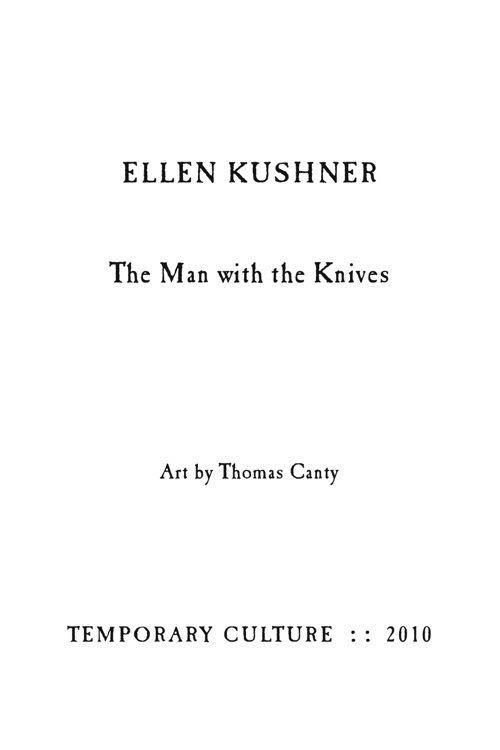
The first page of text (reduced), immediately below. Details and ordering information here :

How to ship a rare book
Technical difficulties, alas — digital picture transfer failure — have prevented your correspondent from presenting pictures of a supremely rare book carefully packed inside a rigid plastic carton marked English Peas. The book arrived in good order, and was neither English nor Peas. I remind readers of an earlier post, here.8 April 10
‘ so much unruly experience in an object . . . a counter-history of the book ’
— Strange and Wonderful. An Informal Visual History of
Manuscript Books and Albums.
Introduction by Jed Perl. [Edited
and compiled by Dan Wechsler. Designed by Fabio Cutro].
Sanctuary
Books,
2010.

Strange & Wonderful is a beautiful guide to the pleasures “ admired and ignored ” of the manuscript book, that is : hand-made compilations of text and/or images. The brilliant introduction by Jed Perl is at once genially digressive and closely analytical of the diverse phenomena of the manuscript book. It is “ a story of the survival of the pre-Gutenberg vision of the book into the post-Gutenberg age ” : the materials surveyed range from a 1440s chained book to recent artist books, Mermaids by Matt Weber and Orgasm and Another Orgasm by Heide Hatry. Perl observes, “ The volume that strikes one person as deliciously strange can be dismissed by another person as merely odd. ” Your correspondent enjoyed them all, but lingered at Hair Samples, Mosses, and the page of hands in the Travel Journal.
This is the portrait of a collection assembled by Dan Wechsler and Fabio Cutro’s stylish design captures many amazing visual elements in this alphabetical journey from Advertising and Album Amicorum to Herbarium to Scrapbook and Sex to Weaving. At the back of Strange and Wonderful , a descriptive Index provides a picture of the cover and records place and date as the primary characteristics, and also demonstrates Wechsler’s organizing vision. It would be rash to use the word philosophy to describe the deeply personal response to the hand-made book object that Strange & Wonderful articulates here, but Wechsler’s book is at once considered and spontaneous : an engaging glimpse of a vast, waiting universe, and an invitation to explore.
Hugo Nomination for Hope-in-the-Mist
Michael Swanwick’s Hope-in-the-Mist , published last year by Temporary Culture, has been nominated for a Hugo award for best related book, in a line-up that includes Canary Fever by John Clute, On Joanna Russ , edited by Farah Mendlesohn, and other distinguished works. Temporary Culture is delighted for this recognition of Michael Swanwick, and pleased to see affirmed the principle that a book’s quality and influence are not solely dependent upon print run or sales. Swanwick comments here.
‘ useful literary drudge ’
Mr. J. H. Burn.
Mr. Jacob Henry Burn died in St. Mary’s Hospital, Paddington, on the
19th Feb. at the age of seventy-six, having been seized with apoplexy
in the street.
This useful literary drudge belonged to a class
of men now seldom met with. Dr. Johnson talks of Abel Roper’s Man Toby. Sir Walter
Scott makes Mr.
Jonathan Oldbuck
speak with veneration of some black-letter collector who had obtained the
soubriquet of Snuffy Jemmy; and bursts out with enthusiasm “ Happy
Snuffy Jemmy ! and happy the days when industry like thine was rewarded ! ” Some can still
remember Michael Stace of Scotland-yard, who republished several rare tracts,
and lived
by completing sets of the Gentleman's Magazine.
Burn in early life was a bookseller’s assistant
employed by the well-known William Hone, whose daughter he married. He assisted
Hone not only in his
business, but
in The Every-day Book and other works which he compiled. Subsequently
Mr. Burn entered into business for himself. His first shop was in Maiden-lane,
Covent-garden,
at that time a great resort of old booksellers, as was also Russell-court;
but the widening of the Strand spoiled that thoroughfare. Next he was in
King-st. Covent-garden, adjoining the passage to St. Paul’s church.
Within these few
years
he was in lodgings in St. Martin’s-lane, opposite Messrs. Harrisons’ printing-office.
Dealing particularly in numismatic works, he was engaged by Mr. Henry B.
H. Beaufoy to form a collection of the Tokens which were struck for current
change
in the
seventeenth century by the Traders, Taverns, and Coffee-houses of London ;
and, after Mr. Beaufoy had presented that collection to the Library at Guildhall,
he was employed to edit the Catalogue. This was printed at the expense of
the Corporation of London, in 8vo. 1853, and again in 1855.
He wrote a memoir on the Roettiers, a celebrated
family of medallists, which was read before the Numismatic Society Dec. 17th,
1840, and printed in its Journal.
In 1841 he was engaged in the Strawberry Hill Catalogue, for the renowned auctioneer
George Robins ; to this he published a sort of supplement, with the
prices and names of purchasers.
He also prepared a Catalogue of a large collection
of British Essayists and Periodicals, which had been formed (chiefly by Mr. Burn’s
means, 1830-34) by John Thomas Hope,
Esq. and was presented to the Bodleian Library at Oxford by his son the late
Rev. F. W. Hope, D.C.L. This was printed at Oxford, in 1865, 8vo. (See Macray’s Annals of the Bodleian Library ,
p. 297.)
Mr. Burn was a man full of information on all matters
connected with the booksellers of London for the past sixty years ; and for some
years edited the “ Current
Notes ” of the Price Current , published monthly
by Messrs.
Willis and Sotheran.
— from The Register , 1869
Society of Useful Literary Drudges
This is to announce the formation of the Society of Useful Literary Drudges, with headquarters in New York City and London, with modest but convivial annual gatherings in honor of Jacob Henry Burn (see immediately above) and other predecessors of the society planned in each city. Membership is open by application or nomination : communications, including demonstrations of usefulness in literary matters, may be sent to wessells [at] aol [dot] com or by post to the address below.
Mervyn Peake Archive
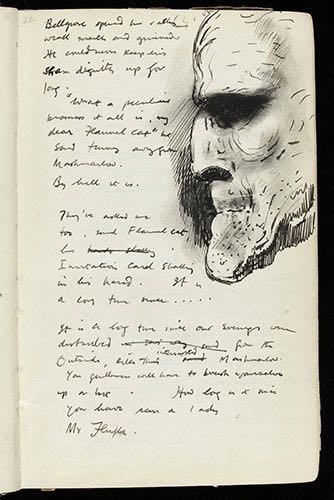
The Guardian reports that the British Library has acquired the Mervyn Peake archive (Gormenghast notebooks, drawings for Alice , etc.).
“ Larry says horses and cows and the like, when they stray, always work up stream. Men, he says, when wandering, go down stream. ”
— Abraham Lansing, The Log Book of Camp Albany (entry for 3 July 1884), in Recollections (Privately printed, 1909).
who saw ?
rhu saw rum, garve saw smoo, nigg saw tain, larg saw lagg, rigg saw eigg . . .
— Edwin Morgan, from “ Canelodia ” (1964), quoted in last week’s TLS NB column.
This is a poem I want to read.
Wander in the Archives
The Archives of the Endless Bookshelf have been swept and tidied and a guide has been prepared to assist wanderers. Index would be too strong a term : the headwords tend to be suggestive rather than directive. Start here. Have fun.
This creaking and constantly evolving website of the endless bookshelf : I expect that some entries will be brief, others will take the form of more elaborate essays, and eventually I will become adept at incorporating comments or interactivity. Right now you’ll have to send links to me, dear readers. [HWW]
electronym : wessells
at aol dot com
Copyright © 2007-2010
Henry
Wessells and individual contributors.
Produced by Temporary
Culture, P.O.B. 43072, Upper Montclair, NJ 07043 USA.

